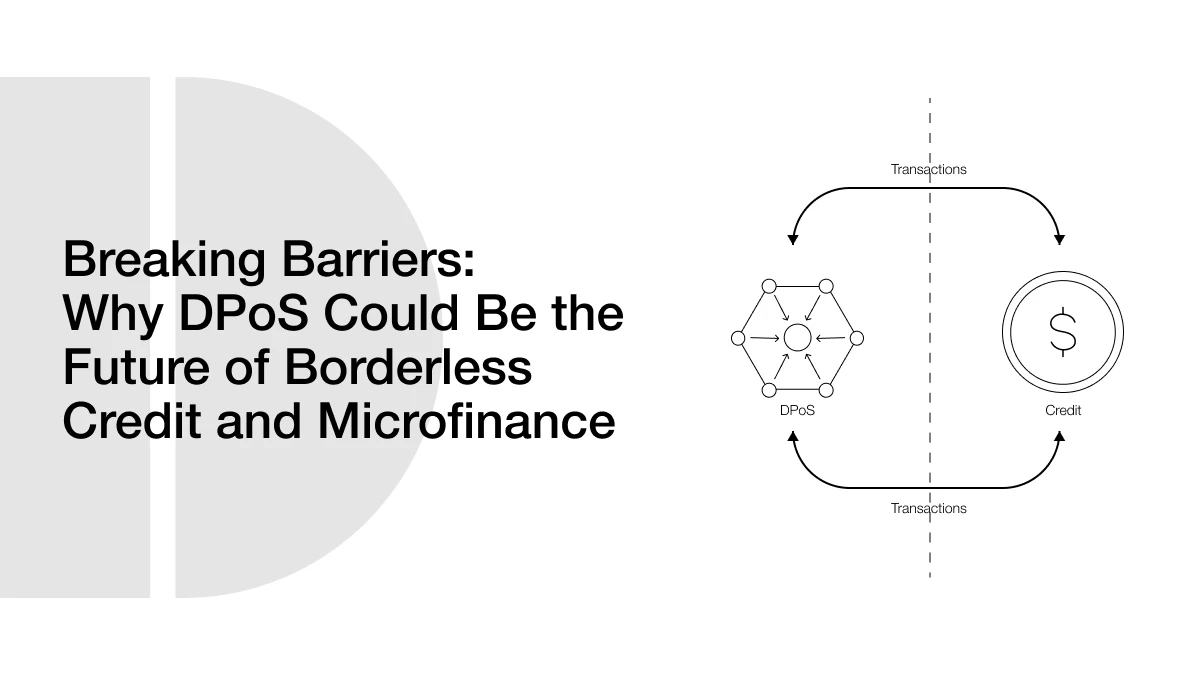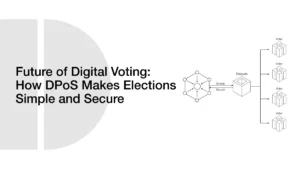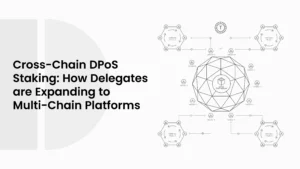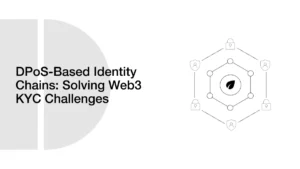Breaking Barriers: Why DPoS Could Be the Future of Borderless Credit and Microfinance

In most parts of the world, access to small loans or transferring money to relatives abroad remains a complex process. It is not an issue confined only to remote villages. People can hardly borrow or lend money easily, even in cities, due to the banking policies, high charges, and time-consuming transfers. Microfinance attempts to correct this by lending out small loans to individuals who would not receive them in conventional banks. The goal of borderless credit networks is to allow lending between individuals in different countries without the need for a bank intermediary.
- What is DPoS and Why It Matters for Microfinance
- Understanding Delegated Proof of Stake
- Why DPoS Works Well for Small Loans
- Linking DPoS to Financial Inclusion
- Comparing PoW, PoS, and DPoS for Microfinance
- The Problem with Traditional Microfinance and Cross-Border Lending
- High Fees and Delays
- Limited Access in Rural and Developing Regions
- Risk of Corruption and Middlemen
- Cost and Time Comparison for a $100 Cross-Border Microloan
- How DPoS Improves Microfinance Delivery
- Instant Settlements Across Borders
- Low Transaction Fees Enable Small-Value Loans
- Transparent and Traceable Transactions
- Sending $50 via Different Payment Methods
- Building Borderless Credit Networks with DPoS
- Decentralized Credit Scoring
- Peer-to-Peer Lending Platforms Powered by DPoS
- Tokenized Loan Contracts
- How This Creates a True Borderless Network
- Real-World Examples of DPoS in Microfinance and Credit
- BitShares—Early Example of Financial Services on DPoS
- EOS—Fast Transactions for Small Payments
- TRON—Connecting Content Creators and Micro-Payments
- Challenges and Risks in Using DPoS for Microfinance
- Technology Access Barriers
- Regulatory Uncertainty Across Countries
- Risk of Wealth Concentration in Delegate Voting
- Need for User Education to Avoid Loss of Funds
- Benefits vs. Risks for Using DPoS in Borderless Credit
- The Future of DPoS-Based Microfinance and Credit Networks
- Integration with Stablecoins to Avoid Volatility
- Partnerships Between NGOs, Fintech Startups, and Blockchain Projects
- Potential for Hybrid Systems with CBDCs
- A Gradual Path to Mainstream Adoption
- Conclusion
- Frequently Asked Questions (FAQs)
- Glossary of Key Terms
Delegated Proof of Stake (DPoS) is a newer blockchain technology that can help both microfinance and borderless credit operate more efficiently. It makes sending money fast, cheap, and secure. Using DPoS, individuals will be able to transfer money to one another without the delay and excessive fees imposed by banks or money transfer services. This is particularly critical in the case of small loans, as the costs may consume the majority of the loan.
Simply put, DPoS can be a global online payment system with its users serving as its operators. It is more energy-efficient and quicker compared to the older blockchain, such as Proof of Work (PoW, which is used in Bitcoin. It is also capable of handling many more transactions simultaneously, which is significant for locations where large numbers of individuals need to send or receive money within a short time (Auer et al., 2024).
For someone in a rural area without a bank, DPoS can act as a bridge to the world economy. All they need is an internet connection and a digital wallet. Lenders in other countries can send small amounts of money directly to them. The borrower can then repay the loan the same way, without long waits or expensive fees. This opens the door to a truly borderless credit system, where your location does not decide your access to finance.
What is DPoS and Why It Matters for Microfinance
Understanding Delegated Proof of Stake
Delegated Proof of Stake (DPoS) is a way for a blockchain network to agree on transactions and keep the system secure. In a DPoS network, people who own tokens get to vote for a small group of “delegates” or “block producers.” These representatives are responsible for verifying transactions and appending them to the blockchain.
This contrasts with older systems such as Proof of Work (PoW), in which computers compete to solve puzzles, or ordinary Proof of Stake (PoS), in which anybody holding tokens can verify transactions. DPoS is quicker since there are a few delegates who are in charge at a given time, and they take turns to add new blocks. This makes it possible to handle many transactions per second, which is very important for microfinance and small-value payments.
Why DPoS Works Well for Small Loans
Microfinance is usually characterized by the transmission of very small loans, less than 50 dollars, to borrowers. In conventional banking or even earlier blockchain applications, the fees might cut a large share of the loan value. DPoS networks are extremely cheap; thus, a large amount of money ends up in the hands of the borrower.
Also, the speed of DPoS means a loan can be sent and confirmed within seconds or minutes, instead of days. This is critical for situations where a borrower needs the funds immediately to buy supplies, pay school fees, or respond to an emergency.
Linking DPoS to Financial Inclusion
According to the World Bank, about 1.4 billion adults worldwide do not have a bank account. Many of these people live in rural or developing areas where banks are far away, documents are hard to get, and fees are too high. DPoS gives them a way to join the financial system using just a phone and an internet connection.
Under DPoS, microfinance organizations can access the borrowers without the involvement of multiple intermediaries. This can save money, build more trust, and open up loans to individuals who previously fell outside of the process.
Comparing PoW, PoS, and DPoS for Microfinance
| Feature | Proof of Work (PoW) | Proof of Stake (PoS) | Delegated Proof of Stake (DPoS) |
| Transaction Speed | Slow (minutes to hours) | Medium (minutes) | Fast (seconds) |
| Fees | High | Medium | Very Low |
| Energy Use | Very High | Low | Very Low |
| Scalability | Limited | Good | Excellent |
| Best For | Large, secure transfers | General payments | Small loans, micro-payments |
The Problem with Traditional Microfinance and Cross-Border Lending
High Fees and Delays
The loans of traditional microfinance are usually transferred via multiple intermediaries, including local banks, regional financial offices, and international payment processors. Every step can introduce costs and time. An example of this is that remitting money via SWIFT or a conventional remittance provider may take three to five days. Add to that, there is a fee of between 5% and 15% of the amount. In a 50-dollar loan, that may mean the lender has to lose $5-$7 before giving out the cash.
When it comes to cross-border lending, the problem can be worse. Currency exchange rates, hidden charges, and service fees make small loans impractical in many cases.
Limited Access in Rural and Developing Regions
There are very few or no banks in most regions of the world, particularly in rural or remote regions. Individuals may have to drive hours to get to the closest branch, and even then, they would not qualify to open an account. They can lack the proper identification papers or do not have sufficient savings to cover the minimum balance provisions.
Microfinance programs try to fill this gap, but they also depend on local partners who may not have the infrastructure to process cross-border payments quickly or cheaply.
Risk of Corruption and Middlemen
When many parties are involved in a financial process, there is a higher risk that funds could be mismanaged, delayed, or misused. In other situations, borrowers get less than the original amount due to unauthorized deductions along the way. Middlemen may also drag the process, and it may be difficult to have microfinance respond to the urgent needs.
ALSO READ: How Stablecoins Strengthen Liquidity, Speed, and Stability in DPoS Networks
Cost and Time Comparison for a $100 Cross-Border Microloan
| Method | Average Time to Receive Funds | Average Fee (as % of $100) | Amount Borrower Gets |
| Bank Wire (SWIFT) | 3–5 days | 8–15% | $85–$92 |
| Western Union / MoneyGram | 1–3 days | 5–10% | $90–$95 |
| PayPal International | Minutes–1 day | 4–8% | $92–$96 |
| DPoS Blockchain | Seconds–minutes | 0.1–1% | $99–$99.90 |
As this table shows, DPoS has the potential to deliver almost the full loan amount to the borrower, and it does so much faster than traditional systems.
How DPoS Improves Microfinance Delivery
Instant Settlements Across Borders
One of the biggest advantages of DPoS is speed. In traditional systems, cross-border loans often take days to process because they pass through multiple banks and payment processors. In the case of DPoS, the verification of the transaction is done by the elected representatives and then appended to the blockchain in a few seconds. This implies that a borrower can get money quickly regardless of the location in the world.
In the case of microfinance, this is significant since most of the loans are required to solve an emergency, such as the purchase of raw materials in a business, school fees, or hospital bills. The convenience of providing money with no delay can significantly influence the life of the borrower and the success of his/her projects.
Low Transaction Fees Enable Small-Value Loans
The loans taken in microfinance are usually small, as low as 50 dollars or less. When the transfer fees are expensive, it may render the loan useless. Fees that are paid in DPoS transactions are very minimal, sometimes a few fractions of a cent. This enables the lenders to send even the smallest amounts without thinking that the cost will surpass the benefit.
Transparent and Traceable Transactions
All the DPoS transactions are stored using a public blockchain. This implies that lenders as well as borrowers can monitor the location of the money at any given time. In the case of microfinance institutions, this visibility creates confidence and minimizes the possibility of fraud or abuse. It also facilitates proving that the intended recipient received funds.
Sending $50 via Different Payment Methods
| Method | Average Speed | Fee % of $50 | Amount Received by Borrower |
| Bank Transfer (SWIFT) | 3–5 days | 8–15% | $42.50–$46 |
| Western Union / MoneyGram | 1–3 days | 5–10% | $45–$47.50 |
| PayPal International | Minutes–1 day | 4–8% | $46–$48 |
| DPoS Blockchain | Seconds | 0.1–1% | $49.50–$49.95 |
This table makes it clear that DPoS is the fastest and most cost-efficient way to send small loans internationally. The borrower gets almost the full amount, and they receive it immediately.
Building Borderless Credit Networks with DPoS
Decentralized Credit Scoring
In traditional banking, a person’s ability to get a loan depends heavily on their credit score. If they don’t have a history with a bank or have no official financial records, they are often denied credit. With DPoS-based systems, creditworthiness can be established in a different way.
Blockchain networks can apply decentralized credit scoring instead of relying on a centralized credit bureau. This implies that your lending history, payment histories, and even credit ratings are recorded in the blockchain. Since such data is clear and safe, it can be viewed by lenders all over the world, and they can make decisions without using traditional paperwork.
Peer-to-Peer Lending Platforms Powered by DPoS
DPoS allows the creation of peer-to-peer (P2P) lending platforms that operate across borders. On these platforms, a lender in one country can directly provide funds to a borrower in another country. There’s no bank in the middle, no international wire, and no unnecessary waiting.
The smart contracts on a DPoS network automatically enforce the loan terms. This ensures the borrower repays on time and the lender receives the funds without manual follow-up.
Tokenized Loan Contracts
In a DPoS-based credit network, loans can be tokenized as contracts. It is a type of digital contract that is saved on the blockchain and automatically sends or freezes funds when particular conditions are met. In case a borrower is to pay 10 dollars per week over 5 weeks, the smart contract will monitor payments, and it will notify the lender upon payment.
This automation reduces administrative costs, eliminates disputes, and builds trust between lenders and borrowers who may never meet in person.
How This Creates a True Borderless Network
By combining decentralized credit scoring, P2P lending, and tokenized contracts, DPoS enables a system where location, currency, and local banking rules are no longer barriers. A farmer in Kenya could receive a loan from an investor in Canada within minutes. A student in the Philippines could borrow from a small lender in Germany without going through a bank.
All of this happens on a secure, transparent network that runs 24/7, unaffected by national borders or business hours.
Real-World Examples of DPoS in Microfinance and Credit
While the idea of using Delegated Proof of Stake for microfinance and borderless credit might sound new, several blockchain projects already use DPoS in ways that can support these goals. Some are direct examples, while others show how the same infrastructure could easily be applied to microfinance networks.
BitShares—Early Example of Financial Services on DPoS
Among the earliest blockchains to adopt DPoS is BitShares. It was created as a decentralized exchange (DEX) and also implemented the possibilities of stablecoins and peer-to-peer financial services. On its network, users could issue and trade digital assets, including tokens of fiat currencies. This theoretically allowed lenders to shift out of stable-value loans without worrying about volatility in cryptocurrencies.
EOS—Fast Transactions for Small Payments
EOS is another high-performance blockchain that employs DPoS to handle thousands of transactions every second. Although it is largely recognized as a platform that hosts decentralized applications, it is fast and has low transaction fees, and thus it is suitable when transferring microfinance. An NGO may, say, give out the $20 piece of aid to thousands of people simultaneously, and within a few seconds, without incurring a high cost of using a third party.
TRON—Connecting Content Creators and Micro-Payments
TRON also runs on DPoS and has a large ecosystem of decentralized apps. While its main focus is entertainment and content sharing, its infrastructure supports instant micro-payments. This means small cross-border payments, whether for lending, donations, or income, can happen with minimal cost.
ALSO READ: Data Processing with DPoS and Edge Computing: Blockchain’s Future Looks Bright
Challenges and Risks in Using DPoS for Microfinance
Even though DPoS has many benefits for microfinance and borderless credit, there are still obstacles that could slow down its adoption. Understanding these challenges helps lenders, borrowers, and developers prepare for them.
Technology Access Barriers
Not all people are connected to the internet or possess a gadget required to access blockchain-based services. In some rural or low-income regions, citizens might lack smartphones, stable electricity, and cheap data plans. In their absence, they are not able to operate a digital wallet or access a lending platform. It implies that, although DPoS can eliminate the banking barriers, it cannot operate without basic digital access.
Regulatory Uncertainty Across Countries
Cryptocurrencies and blockchain technology are regulated differently in different countries. Crypto is promoted in certain locations and prohibited in others. These rules have to be followed by microfinance initiatives that operate via DPoS, and these policies may make international lending complex. The sudden change of laws by a country may prevent the usage of the network by a borrower or a lender.
Risk of Wealth Concentration in Delegate Voting
In a DPoS system, people with more tokens have more voting power to choose delegates. This can lead to a small group controlling most of the block production, which could affect fairness. For microfinance, this might not stop daily transactions, but it could reduce trust if participants feel the network is too centralized in practice (Juodis et al., 2024).
Need for User Education to Avoid Loss of Funds
If someone loses their private key, they lose access to their wallet permanently. For people new to digital finance, this can be a big risk. Education on how to store keys securely, avoid scams, and use the technology safely is essential. Without proper knowledge, borrowers could lose loan funds, and lenders could lose investments.
Benefits vs. Risks for Using DPoS in Borderless Credit
| Benefits | Risks / Challenges |
| Fast, low-cost cross-border transactions | Limited internet and device access |
| Transparent and traceable payments | Uncertain legal status in some countries |
| Works with very small loan amounts | Voting power can concentrate among the wealthy |
| Enables peer-to-peer lending without banks | Risk of losing funds due to poor key management |
The Future of DPoS-Based Microfinance and Credit Networks
The future of DPoS in microfinance looks promising because it offers speed, low costs, and transparency, three things that traditional financial systems struggle to provide for small loans and cross-border lending. But the real potential will come when DPoS is combined with other technologies and financial tools.
Integration with Stablecoins to Avoid Volatility
One of the main challenges in blockchain-based lending is cryptocurrency price volatility. A loan given in a coin that fluctuates in value can cause losses for either the lender or the borrower. Using stablecoins, cryptocurrencies tied to a stable asset like the US dollar, can fix this problem. A stablecoin on a DPoS network keeps the speed and low fees, but removes the risk of sudden price drops.
Partnerships Between NGOs, Fintech Startups, and Blockchain Projects
NGOs or small financial institutions run many microfinance programs. By partnering with blockchain developers, these organizations can bring DPoS-powered loans to rural areas faster. For example, a fintech startup could build a mobile app that connects directly to a DPoS blockchain, allowing instant loans funded by donors or investors around the world.
Potential for Hybrid Systems with CBDCs
Central Bank Digital Currencies (CBDCs) are digital versions of national money issued by governments. If CBDCs become common, they could be integrated into DPoS lending systems. This would make it easier for governments to approve blockchain-based microfinance while still keeping the benefits of fast, low-cost transactions. However, this approach would require careful balance to maintain the decentralization that makes DPoS so attractive.
A Gradual Path to Mainstream Adoption
Large-scale adoption will take time. It will require better internet access in rural areas, more user education, and clear rules from governments. But the progress so far shows that borderless lending on DPoS networks is not just possible, it’s already happening in small pilots. The challenge now is scaling these solutions while keeping them fair, secure, and affordable.
Conclusion
Delegated Proof of Stake is more than just a faster and cheaper blockchain system. For microfinance and borderless credit networks, it represents a way to finally break the barriers that have kept billions of people out of the financial system. By allowing instant, low-cost transactions and creating a transparent record of every payment, DPoS gives lenders and borrowers a direct connection that doesn’t depend on banks, long processing times, or high fees.
For someone living in a rural village without a bank nearby, DPoS could mean receiving a loan in minutes rather than weeks. For a lender in another country, it can mean sending funds directly and knowing exactly where they go. When combined with tools like stablecoins, decentralized credit scoring, and smart contracts, the technology can make lending truly borderless and inclusive.
Of course, challenges remain, from limited internet access to unclear regulations, but these can be solved through better infrastructure, education, and cooperation between governments, NGOs, and blockchain innovators. The early examples show that this isn’t just a theory; it’s already being tested in real communities.
The future of microfinance could be one where location doesn’t limit opportunity. DPoS has the potential to make that future a reality, connecting people across continents in a fair, fast, and transparent financial network. The technology exists, the next step is using it to build a world where everyone can access the credit they need to grow, no matter where they live.
Frequently Asked Questions (FAQs)
Q1: What is DPoS in simple words?
DPoS, or Delegated Proof of Stake, is a blockchain system where token holders vote for a few delegates to confirm transactions. This makes it faster and cheaper than older systems like Proof of Work.
Q2: How can DPoS help microfinance?
It allows small loans to be sent instantly with very low fees, making microfinance more affordable and accessible to people without bank accounts.
Q3: Can DPoS work across countries?
Yes. DPoS enables borderless credit networks where lenders and borrowers can connect directly, no matter where they are in the world.
Q4: What are the risks of using DPoS for lending?
Some challenges include limited internet access in rural areas, unclear regulations in certain countries, and the need for users to protect their private keys.
Q5: Is DPoS better than traditional bank transfers?
For small, cross-border payments, yes. It’s faster, cheaper, and more transparent, which is important for microfinance and small-value loans.
Glossary of Key Terms
- DPoS (Delegated Proof of Stake): A blockchain consensus method where token holders vote for a small number of delegates to validate transactions.
- Microfinance: Small loans given to individuals, often in developing regions, to start businesses or cover essential expenses.
- Borderless Credit Networks: Lending systems that operate internationally without relying on traditional banks.
- Stablecoin: A cryptocurrency tied to a stable asset like the US dollar to reduce price volatility.
- Smart Contract: A self-executing agreement stored on the blockchain that runs when conditions are met.
- Decentralized Credit Scoring: A blockchain-based system that uses transaction history instead of traditional bank credit reports to assess borrowers.




